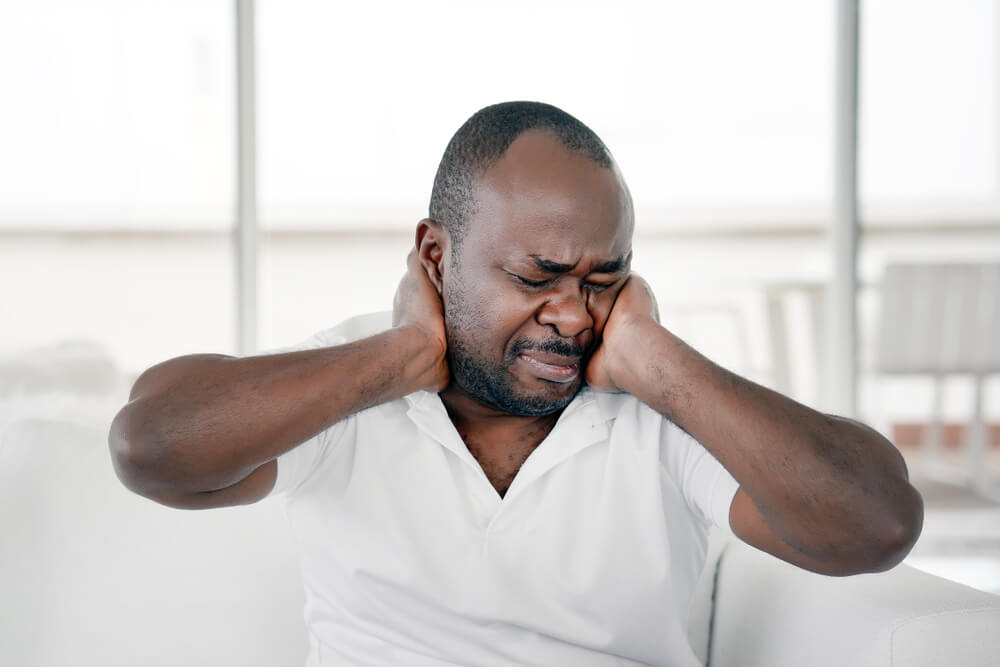Where are most TMJ headaches located?

While it’s easy to assume that all headaches are located in the forehead, there are actually many different types of headaches, and they can each be felt in different parts of the head. By pinpointing exactly where the headache is coming from, you can narrow down the possible causes.
TMJ dysfunction is a common condition that stems from the jaw but can affect different parts of the head and neck. Headaches are one of the major symptoms of TMJ dysfunction and can be felt in more than one location of the head. TMJ headaches are usually located in the forehead and temples as well as down through the cheeks and jaw.
We’ll talk about the basics of TMJ dysfunction, how it’s connected to headaches and techniques that a physical therapist can use to alleviate the pain.
The rundown on TMJ dysfunction
Let’s start off by talking about the condition causing your headaches. TMJ stands for temporomandibular joint, which connects your skull to your jawbone and works as a sliding hinge for jaw movement.
Even though TMJ is the acronym for the joint, it’s often used to refer to TMJ dysfunction or disorder. TMJ disorder affects up to 12% of the general adult population. The disorder means that the joint and surrounding muscles aren’t properly working. It causes a variety of symptoms, besides headaches, including:
- Jaw pain.
- Reduced jaw movement.
- Clicking or popping jaw sounds.
- Ringing in the ear.
How TMJ dysfunction causes headaches located in the temples and cheeks
Headaches are one of the most common symptoms of TMJ dysfunction (TMJD). In a study with more than 1,000 TMJD patients, approximately 67.3% experienced headaches.
TMJ headaches can affect both sides of the face, but it’s not unusual for the pain to be felt on just one side. The headaches from TMJ dysfunction are usually due to referred pain, which means that the ache is being felt in an area that’s different from the source. In this case, the referred pain is in the temples, forehead and cheeks. It’s possible for the referred pain to spread down the neck as well.
Besides referred pain, TMJ headaches can stem from the muscles alongside your cheeks and in your head tensing up during jaw movement, such as grinding your teeth.
Comparing TMJ headaches to other types
It’s not always easy to differentiate one type of headache from another. TMJ headaches can often mimic two other common types of headaches: tension headaches and migraines.
A TMJ headache is often misdiagnosed as a tension headache, because they are both caused by pressure in the muscles alongside your head. Even though migraines aren’t a symptom of TMJ dysfunction, people with migraines are more likely to develop TMJ dysfunction and vice versa. Migraines can also worsen in frequency and intensity for people who have TMJ pain.
By acknowledging other TMJ dysfunction symptoms, such as clicking sounds or restricted jaw movement, you can determine if you’re experiencing a TMJ headache as opposed to a tension headache or migraine. It’s also important to discuss your pain with your health care provider so that they can pinpoint the cause of your headaches.
Physical therapy can reduce TMJ headaches
TMJ headaches can interfere with your ability to focus on your day-to-day activities, which is why it’s important to explore the treatment options that can help. Even though you may be feeling TMJ headaches in your temples, forehead and cheeks, your treatment should be focused on the jaw joint. By treating the source of the pain, you can reduce your TMJ headaches.
Physical therapy is one of the best courses of action for TMJ headaches. Not only can a physical therapist decrease the current pain in both your jaw and your head, but they can also help you decrease potential TMJ headaches in the future.
Here are three techniques that can help alleviate TMJ headaches:
- Manual therapy — A physical therapist can use their hands to reduce the tension in the muscles surrounding the temporomandibular joint. By manipulating the tissue, they can improve the mobility of the jaw and decrease the pain that’s leading to TMJ headaches.
- Exercises — Jaw exercises, such as gentle stretches, can relax the tight muscles that are causing your TMJ pain and headaches. A physical therapist can also show you exercises that can strengthen the surrounding muscles to improve the function of the temporomandibular joint for movements while reducing future pain.
- Posture correction — Poor posture plays a large role in TMJ headaches, because misalignment is a common cause of both TMJ dysfunction and headaches. A physical therapist can help you make gradual adjustments to your neck and back posture to improve your alignment.
Franklin Rehabilitation can address and treat your TMJ headaches
TMJ headaches can affect nearly every part of your head, from your temples down to your jaw. The good news is that Franklin Rehabilitation can help tackle your TMJ disorder that’s causing your headaches. With techniques like manual therapy and jaw stretches, you can reduce your TMJ headaches that are often located down the side of your head.
Call us or request an appointment today to treat your TMJ headaches.
